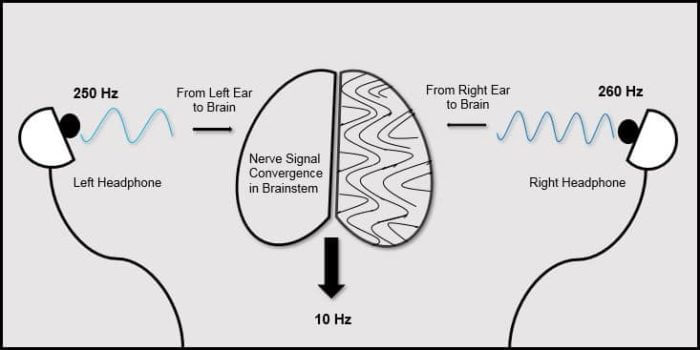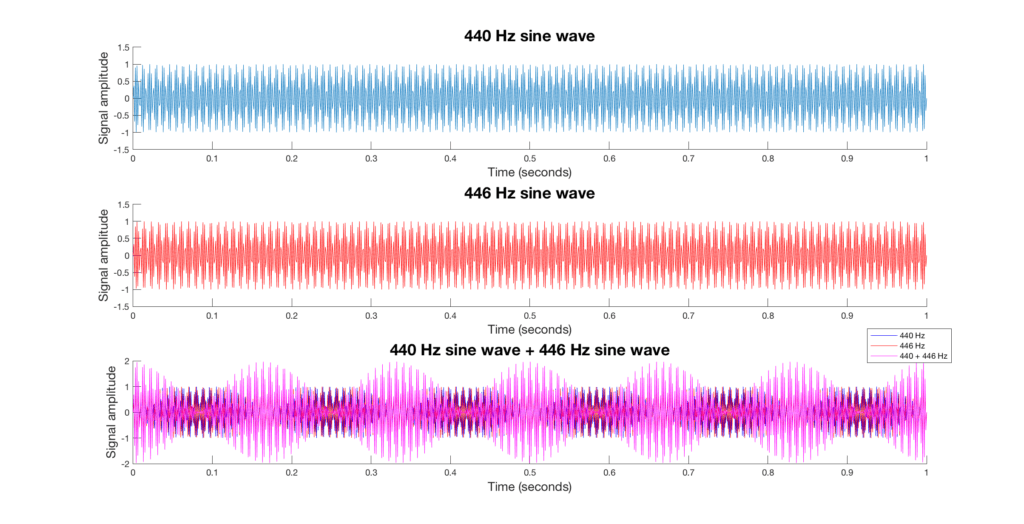What Are Binaural Beats? What’s Their Effect On Us?
Have you ever tried to stop thinking? If you’re a human with no prior experience in meditation, you will have noticed that as soon as you manage to dim your mind to silence, thoughts soon seep in from everywhere.
Many say that binaural beats help us focus, relax, sleep, and meditate. That’s right. Binaural beats promise to help us get what we want to do done and help us find power over our minds.
I know that this sounds too good to be true. A natural phenomenon allows us to channel our energy in more productive and healthy ways? Really? Do binaural beats really work?
Well, to answer that I think we should explore what binaural beats are.
What Are Binaural Beats? What is the Frequency-Following Effect?
A binaural beat is an illusion that our brain creates when we listen to two tones at the same, and the two tones only have a slight difference in frequencies. Our brain interprets the two tones as its own beat. The frequency that our brain will interpret is the difference in hertz (Hz) between the two tones.
If we’re listening to a 134 Hz tone in our left ear and a 141 Hz tone in our right ear, we’re hearing a 7 Hz tone.

Whenever we listen to a binaural beat, the frequencies of our brain waves align with the frequency of the binaural beat. We call this the Frequency Following Effect (FFR), and it’s what allows us to use binaural beats to train our brain waves to reach certain frequencies.
The Frequency Following Effect that binaural beats induce in humans is also established across many other species too! It’s an evoked potential that’s generated inside us by periodic or nearly-periodic auditory patterns (stimuli). The beating of a drum can also induce the Frequency Following Effect. Tribal music, for example, can be hypnotic because of the Frequency Following Effect.
Listening to Binaural Beats isn’t Like Listening to Music
The difference between binaural beats and conventional listening is that binaural beats seem to engage more neural circuits. We’re capturing a specific frequency band and playing it directly to our hearing system, which enables us to experience brainwave entrainment (more on this soon).
Binaural beats (from Latin “with both ears”) have been peddled as “digital drugs”, producing all sorts of effects from improving sleep to enhancing your memory.
Knowing Neurons
A few years ago, Bayer (the pharmaceutical company that manufactures Aspirin) uploaded seven files of binaural beats on their website. The idea was that the beats may put listeners in a relaxed state which could alleviate headaches.
Right now, it’s not certain if this idea or other ideas about binaural beats are true.
If we were playing the two tones with loudspeakers, the two tones would interact, sum, and cancel each other out.

But when we play two tones with headphones, the tones go directly to our ears (with nowhere for the two tones to interact, sum, and cancel each other out). This means you’ll hear a beat of 6 Hz. But with no room for the two waves to interact, the 6 Hz rhythm is entirely in your head.
This means we can only perceive binaural beats with both of our ears.
What is the Superior Olivary Nucleus?
Research is still conflicting, so we still aren’t 100% sure about which brain regions have involvement in generating the binaural beat in our heads. However, the superior olivary nucleus may be the very region.
The superior olivary nucleus sits in our brain stem. It’s is the first part of our brain that processes sound from both of our ears simultaneously. The superior olivary complex actually synchronizes many different activities of the multitude of neurons in our brain too.
It seems to be the superior olivary complex that creates the illusion of the binaural beat. When it hears two close frequencies, it synchronizes the two tones. This creates a binaural beat in our minds and changes our brain waves to match the frequency difference of the two tones. When our neurons synchronize in this way, it’s known as entrainment.
Entrainment is an important characteristic of interactions between brain rhythms and refers to the coupling of two independent oscillatory systems in such a way that their periods of oscillation become related by virtue of phase alignment (Cummins, 2009).
ScienceDirect
But entrainment isn’t just related to binaural beats. It’s an everyday brain function!
Some research has suggested that listening to certain binaural beats can increase the strength of particular brain waves. In turn, this increases or holds back brain functions that control our thinking and feeling.
A Brief History of Binaural Beats
Heinrich Wilhelm Dove was a Prussian physicist and meteorologist who discovered binaural beats in 1839. Dove was the one who realized that for the process of entrainment to work, the perceived tone must only exist within our hearing system. More specifically, the part which processes stereo sound (input from both ears).
But this theory only remained a curiosity for the longest time. A lot of what we know about binaural beats today comes from an article by Gerald Oster, a biophysicist, that the Scientific American published in 1973.
Oster saw the potential for binaural beats to explain how we spatially locate sounds in our environment and selectively single out individual sounds from background noise. But he also saw the potential for diagnosing hearing impairments and a range of seemingly unrelated medical issues with binaural beats.
For example, he found strong data that suggested those with a diminished ability to hear binaural beats were more likely to get Parkinson’s Disease. More specifically, a diminished ability to hear binaural beats was an early indicator of Parkinson’s Disease.
But what sparked further research into how binaural beats can help us focus, improve our memory, etc., is that binaural beats involve different neural pathways compared to normal hearing functions. Binaural beats can evoke neural responses, even when both tones our left and right ears are hearing are below the threshold of human hearing.
Different Binaural Beats
Neurons in our brain make use of electrical signals to generate thoughts, emotions, and behaviours. When neurons synchronize they create brain waves! We can measure brain waves with a technique known as electroencephalography (EEG). You may have seen this performed in films or on TV, but EEC involves putting electrodes on our scalp to record electoral signals in our brains.
Our brain waves can range from low frequency to high amplitude and high frequency to low amplitude. The brain waves create binaural beats which lead to different mental states which affect the brain in different ways.
There are five different brain waves:
Delta: 1-4 Hz. Delta is the lowest frequency state, and it’s linked to:
- Deep sleep
- Healing and pain relief
- Meditation
- Anti-aging: cortisol reduction/DHEA increase
- Access to the unconscious mind
Theta: 4-8 Hz. Theta binaural beats benefits include:
- Meditation
- Deep relaxation
- Creativity
Alpha: 8-14 Hz. When in an alpha state of mind, you’ll find yourself being productive. Alpha brain waves help you to:
- Relax and focus
- Reduce Stress
- Maintain positive thinking
- Increase your learning capabilities
- Easily engage in activities and the environment because you are in a state of flow
Beta: 14-30 Hz. Beta is a higher frequency brainwave and helps in:
- For keeping your attention focused
- For Analytical thinking and problem solving
- Stimulates energy and action
- High-level cognition
Gamma: 30-100 Hz. With a higher frequency than beta, these brain waves help in:
- Increased cognitive enhancement
- Attention to detail, helping in memory recall
- A different way of thinking, which is a sign of creativity
Benefits of Binaural Beats
It’s said that binaural beats can induce the same mental state associated with a meditation practice, just quicker. In effect, binaural beats can:
- reduce anxiety
- increase focus and concentration
- lower stress
- increase relaxation
- foster positive moods
- promote creativity
- help manage pain
Meditation is a method of calming our minds and being aware of the random thoughts that we can’t help but think of. After all, we don’t ask to think the things we think. By being aware of our random thoughts we can tune them out by thinking about our breathing, where we are, what’s around us, and the weight of our body.

Regularly practising meditation in this way lowers stress and anxiety levels. Meditation also slows down the rate of brain ageing and the loss of memory, lengthens our attention span, and promotes mental wellbeing. But practising meditation regularly can be a little tricky. It’s hard to form a new habit. This is why people look to technology for help.
Binaural beats that sit between 1 and 30 Hz are said to create the brain wave pattern that we would equally experience while meditating. By listening to a sound with a particular frequency, your brain waves synchronize with that frequency.
It’s said that binaural beats help our minds create the frequency needed for our brain to create the same brain waves that we would experience during meditation. The use of binaural beats in this way is sometimes called brain wave entrainment technology.
You’ll find ambient sounds for binaural beat creation in the Mixxed sample library!
The sampling revolution has risen in popularity and shaped music since the early 1970s. Sample culture continues to transform how millions of artists and producers do their thing in DAWs.
You too can break conventional norms, challenge the status quo, and open Pandora’s box of sound design.
Mixxed works with a growing number of sample labels and contributors to provide you with an affordable sample subscription service that’s more accessible than any before.
You’ll have access to our growing catalogue of loops, one-shots and sound effects that you can browse, download and keep forever for less than $3 a month.
Sign up today to find your sound!
